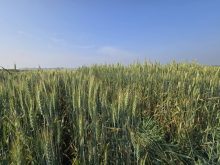The Falcon isn’t taking off just yet.
Shifting CDC Falcon, Manitoba’s most popular Canada Western Red Winter (CWRW) wheat, to the Canada Western General Purpose (CWGP) class, will likely be delayed a year and possibly two.
“What was made very, very clear in the consultation process was that Manitoba Falcon is one of the main (winter wheat) varieties and there has to be a replacement available,” said Norm Woodbeck, Canadian Grain Commission program manager for quality assurance standards and reinspection.
Read Also

Still hard to predict precise fertilizer payback
Despite decades of advances, international research finds no clear answer for where and when adding nutrient will fail to boost growth.
“If (new) material is not available, we will extend Falcon (in the CWRW class), but if there’s enough (new) material out there, Falcon will be switched over as of Aug. 1, 2013.”
Moving CDC Falcon and four other winter wheats – CDC Kestrel, CDC Harrier, CDC Raptor and CDC Clair – out of the CWRW class is intended to improve the milling quality of the class, making it more competitive against American winter milling wheats.
But it now looks that seed supplies of CDC Falcon’s heir apparent in the CWRW class, AC Flourish, won’t be available until the fall of 2013 at the earliest. That’s assuming normal production in 2011 (the crop that’s in the ground now) and 2012, said Todd Hyra, Western Canada business manager for SeCan, which is distributing the Agriculture and Agri-Food variety.
“I wouldn’t want to change the classification on Falcon until the following year – until 2014,” said Hyra. “I’ll have a better idea of seed supplies (for AC Flourish) in the fall of 2012.”
Another new, promising potential replacement for CDC Falcon from Agriculture Canada, WW 454, was recommended for registration last month. If all goes well there will be some certified seed available by 2014, but it won’t be widely commercially available until 2015.
CHECKOFF CONCERN
Moving CDC Falcon to the CWGP class, created to serve ethanol makers and livestock feeders, is important, not only because it almost certainly means farmers will be paid less for CDC Falcon, but because it could also cut Winter Cereal Manitoba’s checkoff earnings.
Those concerns were raised March 16 at WCM’s annual meeting in Winnipeg.
Since winter wheat is seeded in the fall, farmers need to know CDC Falcon’s future well in advance. If the class shift were delayed a year to Aug. 1, 2014, farmers would have to have enough AC Flourish seed in the fall of 2013 to replace CDC Falcon. It could be tight given they’d be planting wheat that was harvested just weeks before.
If stocks are short, it’s possible CDC Falcon would have to remain in the CWRW class until Aug. 1, 2015.
Depending on market conditions, a lot of Manitoba’s CDC Falcon bypasses the Canadian Wheat Board and is sold as domestic feed or for ethanol production. As long as CDC Falcon is in the CWRW class, it’s eligible to be delivered to the
CWB, which sometimes returns higher prices than the feed market. That option will end when CDC Falcon is reclassified.
It’s a concern for MacGregorarea farmer and WCM vice-chair Curtis Sims. When there are big winter wheat crops, farmers need access to as many markets as possible, he said. Too much feed wheat will depress the domestic feed market.
If the shift occurs before there’s a replacement for CDC Falcon it could also cost WCM, warned its manager Jake Davidson.
“If Falcon disappears, there won’t be any levy paid on it,” he said.
The organization’s checkoff applies to winter wheat and while CDC Falcon is a winter wheat if it’s in the CWGP class, much of it will likely be sold as feed, farmer to farmer, instead of going through elevators where the checkoff is collected.
“We know we’re going to lose it (Falcon from the CWRW class), but we’re not going to lose it until we have the right replacement,” he said.
POPULAR
CDC Falcon accounted for 76.5 per cent of the winter wheat seeded and insured in Manitoba in 2010, making it the most popular winter wheat in the province by far.
CDC Buteo, a CWRW “select” winter wheat, is the next most popular at 12.9 per cent of the acres, followed by McClintock (also select) and CDC Ptarmigan at 5.6 and 1.9 per cent of the acres, respectively.
The “select” winter wheats represent almost a class within the CWRW class. Select varieties are segregated and have superior milling and baking characteristics, including consistently higher protein levels than non-select varieties.
A number of years ago, the CWB, with grain industry backing, agreed to reduce some of the end-use standards for registering new winter wheats to encourage their development and give farmers another cropping option.
With the elimination in 2008 of kernel visual distinguishability as a prerequisite to registering new wheats in Western Canada, and the creation of the CWGP class, the industry agreed it was time to revamp the CWRW class so that only “select” varieties would be eligible. (Once that’s done the select designation will be dropped.)
Since CDC Falcon isn’t grown outside of Manitoba, the pending reclassification doesn’t affect Saskatchewan and Alberta.
Winter wheat offers a number of advantages, including the potential for higher yields with less expense and weed control, particularly in a wet spring (if it isn’t drowned out).
CDC Falcon is popular because of its good yield and short stature, which reduces lodging and makes the residue easier to work in.
“AC Flourish yields about the same as CDC Falcon,” Hyra said.
It has similar winter hardiness and while AC Flourish is an inch or two taller, it has better lodging resistance than CDC Falcon, he said. [email protected]
———
“Weknowwe’regoingtoloseit(Falconfrom theCWRWclass),butwe’renotgoingtolose ituntilwehavetherightreplacement.”
– JAKE DAVIDSON














